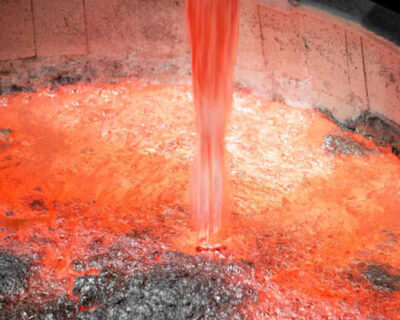Aluminum melt purification technology is the main topic of research in modern aluminum foundry. Its basic direction is to improve the refining effect and improve the purity of the metal as much as possible on the premise of preventing environmental pollution. During aluminum smelting, the oxide film is immersed in the melt. Some floats on the surface of the aluminum melt or stick to the furnace wall, and those aluminum droplets and the surface of the melt are oxidized again, which also forms the inclusions. Once the inclusions mixed into the cast-rolled strip, it will cause defects such as slag inclusion and oxide film. It significantly reduces the mechanical properties and corrosion resistance of the products. Therefore, in the continuous casting and rolling process, the melt must be refined and purified to effectively reduce the content of gas and inclusions, and ultimately produce high-quality sheet and foil materials.
Impurities in Molten Aluminum
Impurities in the aluminum melt, in addition to the metal charge, the molten aluminum may also absorb impurities from the lining, furnace gas, flux, charge, and operating tools during the melting process.
For non-metallic inclusions of aluminum melt, it mainly refers to alumina. Its nature is dense and tough, whether it is in a solid-state or a liquid state, it is easy to form a solid protective layer tightly attached to the surface. The aluminum oxide film, when impacted in the molten state, can easily become a finely divided film, causing the greatest harm. Although the density of alumina can reach 3~4g/cm, it is only 2.3~2.4g/cm at high temperature, which is almost the same as the density of the aluminum solution. Therefore, in the molten aluminum melt, they are actually in a suspended state.
Once the oxidized slag is solidified, it is mixed into the cast strip. Because it can neither be dissolved in the aluminum alloy nor form an intermediate compound with other elements. It can only be distributed in the solid-state at the grain boundaries of the grains, thereby destroying the bonding force between the grains. Because of the existence of such oxidized slag that breaks the intergranular bonding force. It has caused many hazards, reduced the process performance during pressure processing, and caused the delamination of the metal during processing, resulting in cracks. The aluminum product strength is unstable, and the elongation rate is greatly reduced. Especially under impact load or vibration load, ductile fracture occurs, which affects the service life of the material.

Aluminum Melt Purification Measures
In order to reduce the pollution of impurities to metals, the following aluminum melt purification measures can be adopted:
- According to the different chemical properties of the smelted metal or alloy, refractory materials with high chemical stability are used. High aluminum refractory lining should be used for the aluminum alloy.
- New metals with higher purity are used to ensure the purity requirements of certain alloys.
- The flame furnace should use low-sulfur fuel: all tools that come into contact with the metal charge should be made of materials that do not bring impurities as far as possible.
- For conversion alloys, the furnace should be cleaned according to the purity and performance requirements of the two alloys.
- Pay attention to the selection of auxiliary materials.
- Strengthen the furnace charge management to prevent the phenomenon of mixing.
- Install degassing equipment and filtering equipment between the furnace and casting machine, the main purpose of which is degassing and removing impurities.

